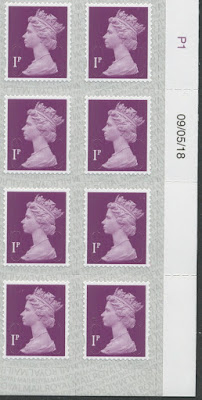 In February 2016 Royal Mail issued the Royal Mail Heritage: Transport set as part of the Royal Mail 500 celebrations. Post & Go issues in 2017 and 2018 have built on the theme, creating a series exploring the transportation of mail in greater detail.
In February 2016 Royal Mail issued the Royal Mail Heritage: Transport set as part of the Royal Mail 500 celebrations. Post & Go issues in 2017 and 2018 have built on the theme, creating a series exploring the transportation of mail in greater detail.
Mail by Bike is the fifth issue in this series and follows Mail by Rail which was issued in February 2017, Mail by Air which was issued in September 2017 and Mail by Sea which was issued on 14th February 2018. Although launched during Autumn Stampex, there will be no Royal Mail vending machines with these stamps at the show.
UPDATE 10 Sept. We understand that although these stamps have been distributed to Post Office branches for their SSKs, they are not being sent to Royal Mail Delivery Offices. Whilst confirmation of the nationwide position is awaited, we know that there are none at Windsor DO, although they are at the PO next door!
Background
Cycles were used for the delivery of mail since at least 1880, when tricycles were trialled in Coventry.
Many designs of machines with two, three, four or five wheels were experimented with, and by 1933 cycle posts covered some 200 million miles (nearly 322 million km) every year. The many suppliers of cycles to the Post Office included Quadrant, Singer, Elswick, James and Pashley, the last of these being
the largest supplier of bicycles to the mail fleet.
The number of cycles peaked at around 36,000 in 2006. In 1903, the Postmaster General reported that experimental motor tricycle posts were being operated in London. In July 1914, the Post Office purchased 20 motorcycle combinations to replace horsedrawn services over routes between 40 and 50 miles (64 and 80km).
More powerful machines available after the First World War encouraged greater use. Solo motorcycles entered letter delivery service in 1924 and telegram delivery in 1933. In later years, motorcycles were used for priority mails, such as Expresspost and Datapost.
Stamps in detail (click on any image to see a larger version.)
 Pentacycle, 1882
Pentacycle, 1882
Five-wheeled ‘Hen and Chicks’ were used for mail delivery in the Horsham district, Sussex, in 1882. Postmen liked these machines, but officials were unconvinced of their practicality, and so their use never extended beyond the initial trials.
 Motorcycle and trailer, 1902
Motorcycle and trailer, 1902
Such a motorcycle and trailer were used in 1902 for delivering letters and parcels to the rural districts surrounding Sittingbourne, Kent. This was very much a local initiative, and it was among the first motorised mail deliveries outside London.
 Tricycle and basket, 1920
Tricycle and basket, 1920
First introduced in 1880, tricycles, with their large wicker baskets, had been ideal for carrying substantial amounts of mail in urban and rural districts. By the First World War, they were antiquated and insufficient for the increasing weight of the mail.
 Bicycle, 1949
Bicycle, 1949
The bicycle was the mainstay of the postal fleet for more than a hundred years, with over 36,000 in use in 2006, followed by a dramatic decline. A standard specification for delivery bicycles remained almost unchanged between 1929 and 1992.
 Motorcycle, 1965
Motorcycle, 1965
Motorcycles were used for mail delivery and collection, as well as for telegram delivery. Various manufacturers supplied them, with BSA being the largest. The BSA Bantam was the much-loved and
reliable workhorse of the fleet between 1948 and 1971.
 Quad bike, 2002
Quad bike, 2002
Honda quad bikes were used for collecting and delivering mail in Scotland between 2001 and 2010. They were ideal for the rough terrain of the Scottish islands Gigha, Iona and Kerrera, allowing Royal Mail to reach locations previously accessible only by foot.
Post & Go stamps are sold from Post
Office Self-Service Kiosks (SSK), which allow customers to weigh their
letters and packets, pay for and print postage stamps and stationery
supplies, often without the need to visit the counter. The first Post
& Go machine was trialled in The Galleries Post Office® in Bristol in
2008. The labels will be used in Post & Go machines at Post
Offices around the country, and from Royal Mail machines at Enquiry
Offices, Museums. These stamps are not available from
machines at Stampex.
The labels can be obtained with 6 different
service indicators: 1st class up to 100g & 1st class Large up to 100g,
a dual-value Europe up to 20g/World up to 10g, Europe 100g, Worldwide 20g,
and Worldwide 100g. From SSKs other stamps can be printed with
monetary values for a variety of services including Special Delivery and
parcels.



























































